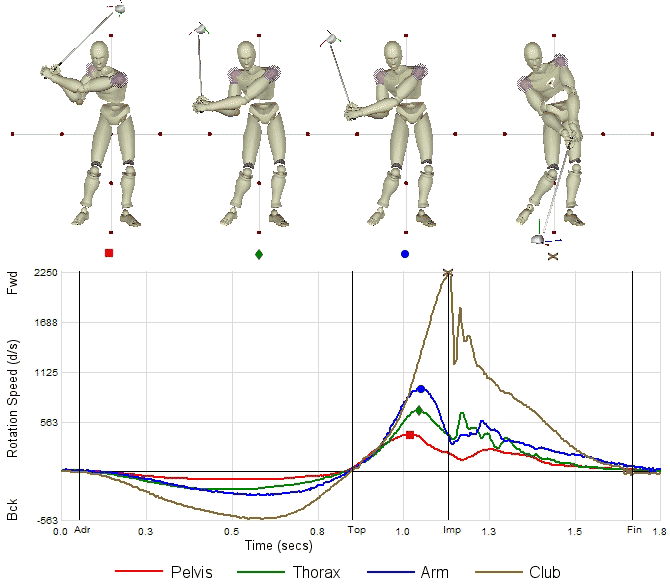An Efficient Golf Swing is All About Decelerating
What? Decelerating? How does that equal efficiency in my golf swing?
A golf swing is not all about just swinging fast and hard. It’s about segmental stabilization and mobility. The speed that is created at the club head is the end result of each of the segments (lower body, torso, arm, and club) accelerating and DECELERATING. The speed and power that is generated by each segment is sequentially transferred to the next segment efficiently when the previous segment is STABILIZED and decelerates.
Professional and amateur golfers were hooked up to motion sensors by the Titleist Performance Institute (TPI), and they arrived at the above graph, which represents a good swing sequence.
Each line represents a segment of the kinematic sequence. Time is the bottom line (X-axis) and speed is the vertical line (Y-axis). The red line is the lower body, the green line is the torso, the blue line is the left arm, and the gold line is the club shaft. As the golf swing progresses, each segment speeds up and then slows down and then the following segment follows the same pattern, until the final segment, the club, swings at a speed that is the summation of all the previous body segments.
The incredible thing is, according to TPI after their study of many PGA tour players, this kinematic sequence and transfer of energy is the same no matter what their swings look like.
The key to consistency and accuracy with the golf swing is a good kinematic sequence; and the key to power and distance is good segmental stabilization. Faults occur when there is a break down in the sequence. Efficiency is lost when a player has poor mechanics, poor conditioning, or poor equipment.
The mechanics of the swing are best analyzed via video with a golf swing instructor, this is their realm of expertise, fixing the swing faults. The conditioning aspect basically takes into account the physical limitations in the body, which can be analyzed by performing a physical screen and addressing the deficits through exercise and training. The equipment is important as well. Proper club fitting at your local golf store can result in a set that is specifically designed to the individual player and fits their body type and size.
However, no matter how expensive or advanced the equipment is or how long you spend with a swing coach, the body can only do what it’s capable of doing. For example, the instructor at the driving range can tell you to “turn your shoulders” over and over again, but if you lack the rotation required through your trunk and hips, then there’s no way that you can perform a proper shoulder turn and then you wind up with movement compensations and swing faults.
How can we fix that? Stay tuned right here.

